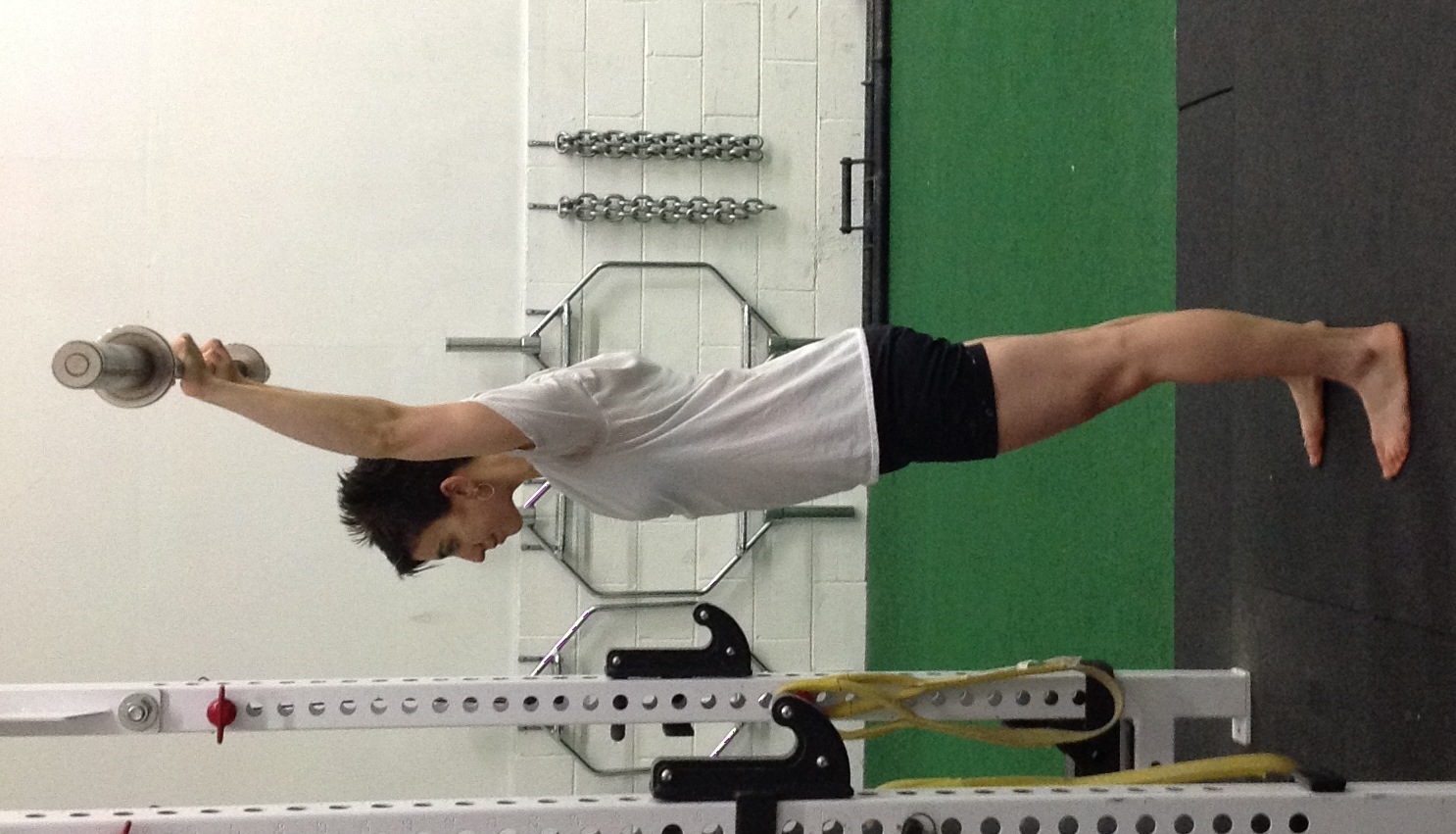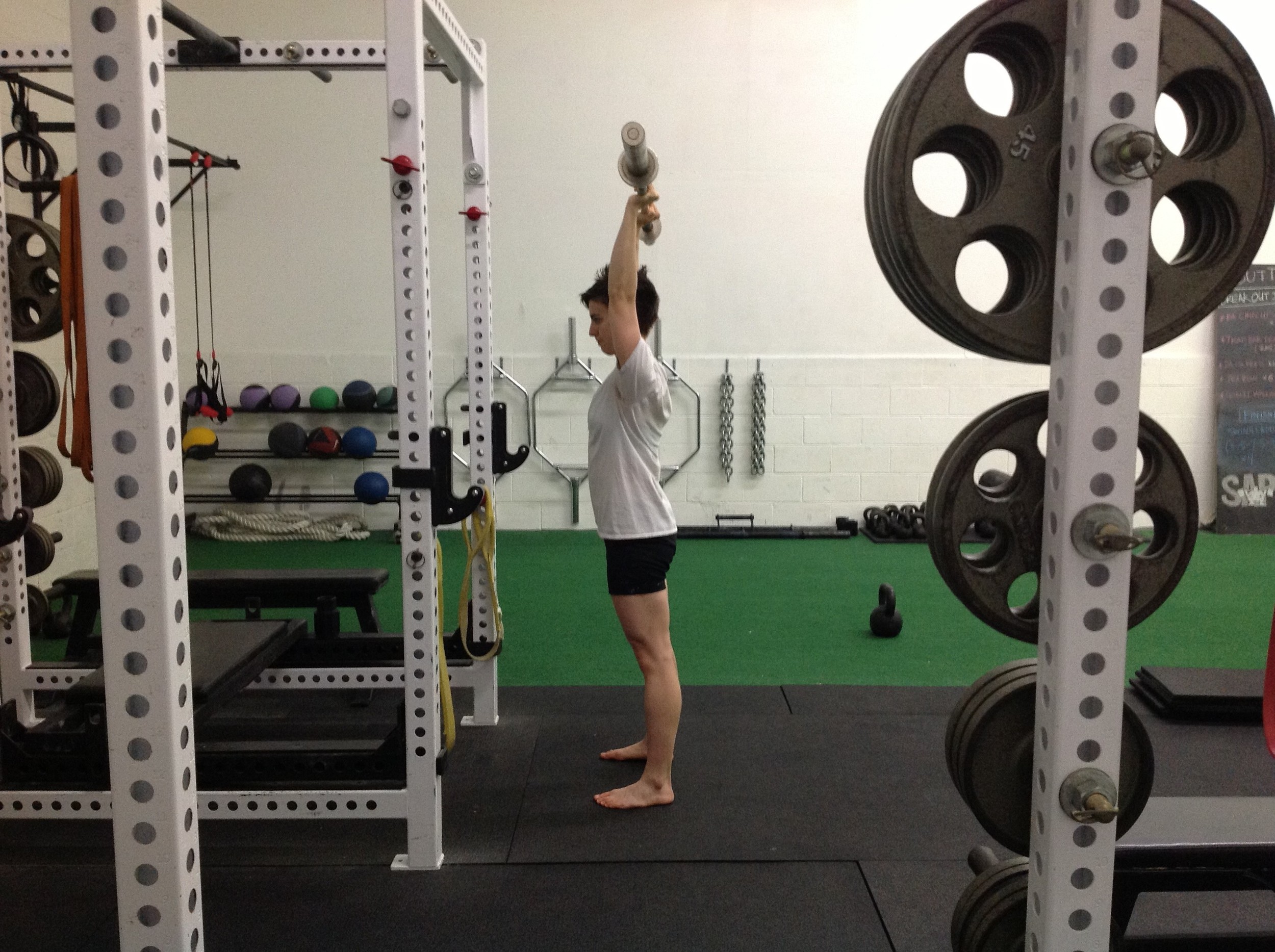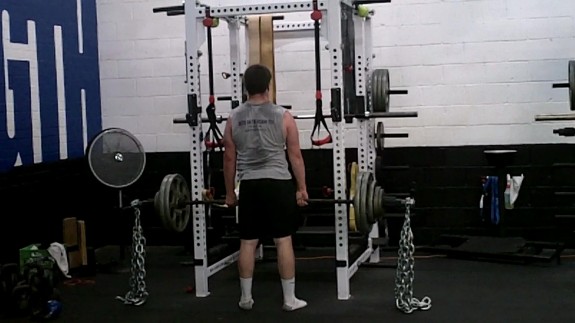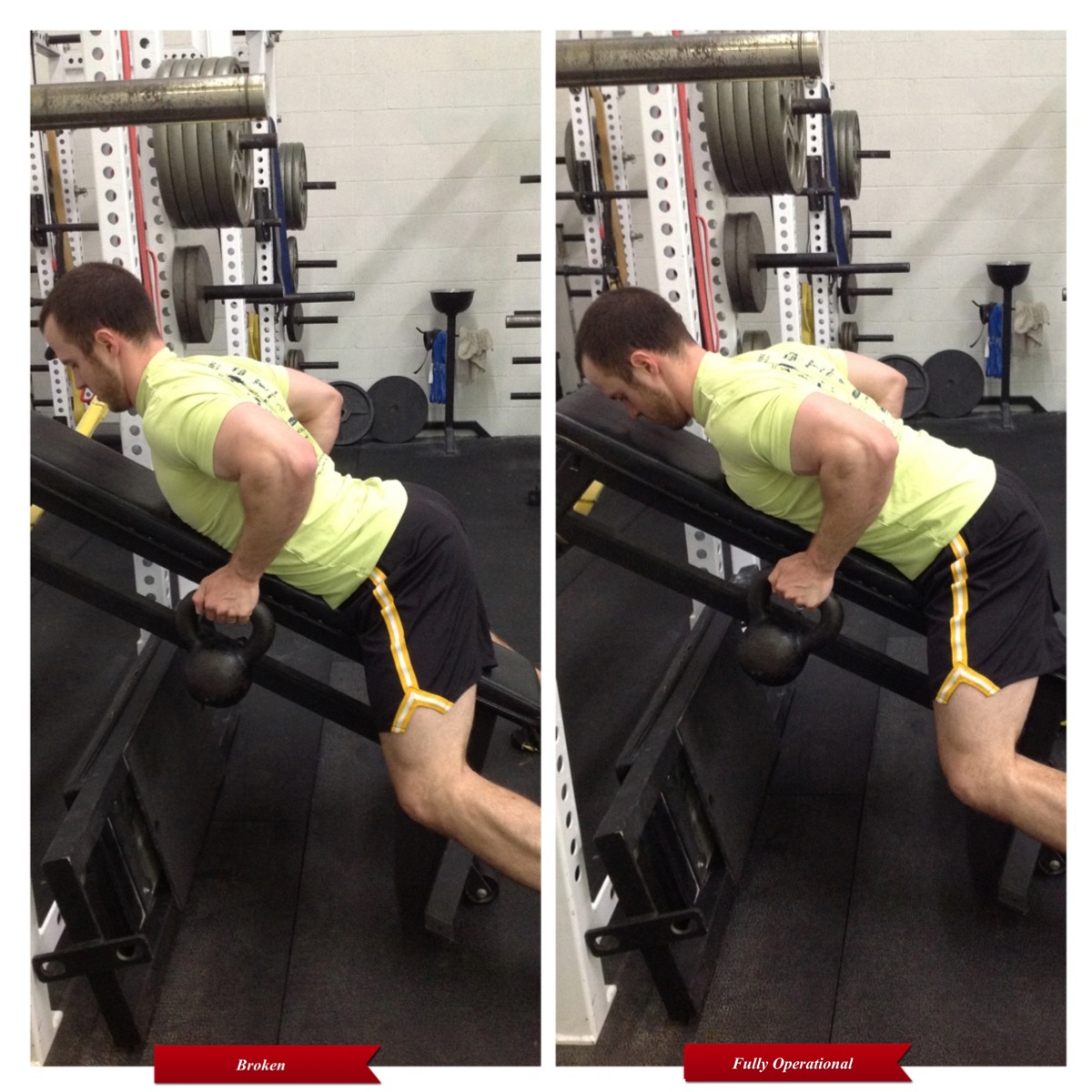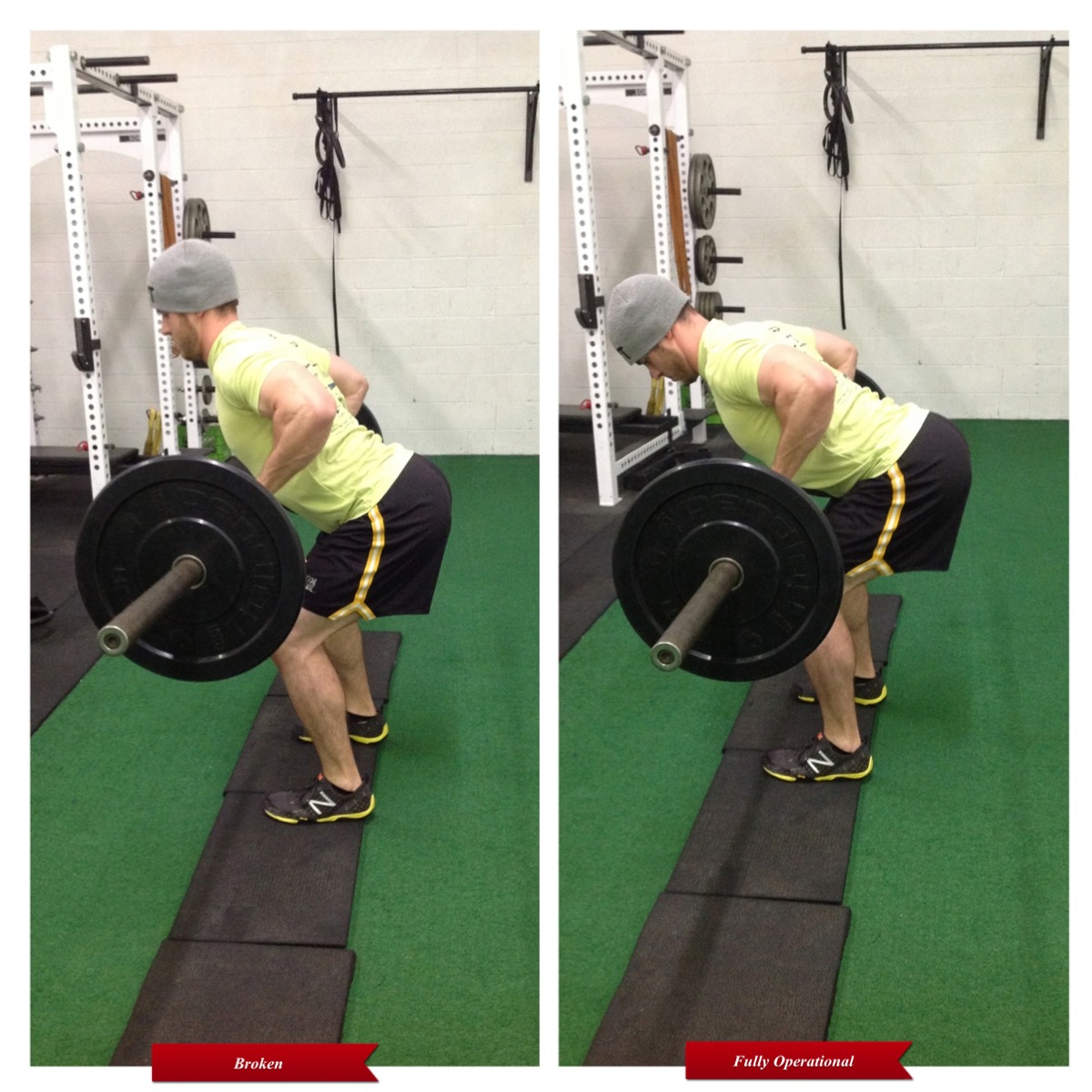Friday Musings 1/18/13: Coaching the Overhead Press, Deadlift Program, Tying the Perfect Tie
No, it is indeed not Friday at the time of posting this....decided to do this round a day early.
1. Coaching the Overhead Press
There's something intrinsically satisfying about pressing a heavy weight overhead, not to mention the host of benefits it provides, provided you don't butcher it. I actually did a little Q & A on overhead pressing HERE, for those interested. Moving on...
A cue often given in the overhead press is to "push the head and body through" at the top, the goal here being to prevent the bar from drifting too far away from the body. However, I often see people woefully abuse this cue to the extreme and jut their head way too far out at the top, slipping into gross extension, especially at the cervical spine:
Those of us coaches in the crowd often experience profuse bleeding of the cornea when we see people perform a pushup with the oh-so-prolific forward head posture, so why is does it all of a sudden become a different ball game when we press vertical instead of horizontal? You can see, if I flip the above picture of Kelsey 90 degrees, where she would be in the horizontal plane:
Not a pretty "pushup" position, right?
Yes, you do want to prevent the bar drifting away from the midline of the body, but be sure to keep the head neutral - aka a packed neck - as you finish the lift at the top:
When we jut the head forward, all we essentially wind up doing is cranking on that levator scapulae - thus cementing a downward scapular rotation pattern (not ideal) - and substituting forward head posture for actual scapular upward rotation and posterior tilt, anterior core stability, shoulder flexion, and T-Spine extension.
Translation: Shoving the head forward turns you into a walking ball of fail.
Keep those glutes tight, abs engaged, ribcage down, and ideally you'll want a vertical line going through the bar, ears, and midfoot when at the top of the press.
2. High Frequency Deadlifting
Back in 2012 I wrote a post called A Little Deadlift Experiment, Part 1, in which I briefly discussed a high-frequency deadlifting plan I used to add 40 pounds to my deadlift in 4 weeks. I never ended up writing Part 2 (yes, fail on my part), but I received a number of questions, both on the blog and through email, on how it ended up.
Well, I actually only ended up doing it for another month, but I did add another ten pounds to my total during that month. Excellent. I stopped it due to the pursuit of a few other goals, but I did want to share that I've "experimented" with the program on other people and it has worked wonders.
Mark - one of my buddies, and a physical therapist - called me up last year year telling me he made a bet with his supervisor that he could eventually deadlift over 400lbs. The kicker? He only had about 4 months to do it, his deadlift 1RM was sitting right around 300lbs, and he made the dreaded Alpo Bet, a la Dan John. So he called me in hopes I could help him add 100lbs to his deadlift in a matter of a few months.
Great.
After berating him on the phone for making me responsible to help him win an absurd bet he never should have made, I gave him the very deadlift program I used.
The result? His deadlift shot up from 300lbs to 435lbs in a matter of five training cycles, leaving him the winner of the bet and relieving him from eating a can of Alpo in front of his supervisor. What?!
Keep in mind, he had over three years of solid lifting experience under his belt, so these weren't newbie gains, either.
Note: All the credit goes to Mark on this one. He worked his tail off - despite the fact that he has a very demanding schedule and was undergoing some significant "life" changes - and trusted me every step of the way with the seemingly asinine program I gave him.
I'm not going to share the program here yet though, as I may end up using it for future article or online program. Patience, patience....
3. Tying the Perfect Tie
This one's for you gents in the crowd.
Maybe I'm a bit of an anomaly here, given that I'm fortunate enough to wear t-shirts and athletic shorts to work each day, but getting ready for an event requiring a tie can be exceedingly frustrating. (Yes, you office workers in the crowd, go ahead and shake your heads in reproach, I realize I have it easy.)
Fortunately, Tim Ferriss seems to be an expert at doing any and every random task extraordinarily well, and tying ties is no exception. Here is a quick, extremely useful video on how to tie the perfect tie, every time.
It can take a couple tries, but once you get it, you're golden. Ever since employing this tactic I've been able to boast the best tie in the room at formal events. What what!
I've run out of musings for the time being, hope everyone has a great weekend.
An Overuse of the "Arch Your Back" Cue, and How to Create Better Positioning During Your Lifts
"Pull your chest through.""Stick your chest out." "Put your shoulder blades in your back pocket." "Arch your back....I said, ARCH!"
If you've ever set foot in the weight room, I bet you've heard at least one of the above verbal cues spat out hundreds of times by a coach or trainer in the middle of teaching someone to lift weights.
And for good reason, considering that this is what I usually see when I watch the average gym-goer set up to perform a deadlift or row:
Not pretty, right? And something that should make you want to throw your face into an axe.
We know that lifting with a round back (flexion), at least in the lumbar region, is exceedingly dangerous, large thanks due to Dr. Stuart McGill and his research showing that repeated lumbar flexion, especially under load, is the exact mechanism for disc herniation.
So, what did we do as an industry? We took the stance that if lumbar flexion is bad, then we should keep people as far away from that as possible. If extending (arching) your back is good, then the more the better, right? This thought process lead to us ensuring that everyone "arched their back," or "pulled their chest through" as much as humanly possible anytime they set up to perform a deadlift, row, squat, you name it.
Guess what? Excessive extension is bad, just as excessive flexion is bad.
Overextension in the lumbar region can be just as evil as flexion. What shows up on your doorstep when you do it for too long? Hellooo to low back pathology, to spondy and her cousins. Hello to facet irritation. Hello to an even greater anterior pelvic tilt. Hello to crazy stiff lats and a weak anterior core. Hello to literally cranking on the passive restraints of your back (not a good thing). Goodbye to stronger lifts.
Below is a bevy of comparisons I've put together, showcasing what is commonly seen as good form (sticking your chest out, or overarching your back), alongside a picture of what your back should look like. The pictures on the left show broken, ugly positioning while the pictures on the right display stable and sound positioning.
Instead of performing our lifts with a hyperextended spine, we want a neutral spine. A neutral spine is a happy spine.
TRX Row
Seated Row
Chest-Supported Row
Bent-Over Row
Anti-Rotation Press
Bent-Over Barbell Row
Goblet Squat (Top)
Banded W
Deadlift (Middle)
It may surprise some of you to see what you may have initially thought of as good form, to actually be broken. And knowing how to cue neutral spine is of even greater importance when you're working with someone with extension-based back pain, or even an athlete who lives and breathes in an extended posture.
And it's no wonder why you see so many ugly internet videos of people performing high rep snatches, with the top of each one looking something like this:
When we have crazy stiff lats and a weak anterior core from performing everything in extension, it's no wonder why so many of us look like utter poo poo when we go overhead.
Closing Thoughts
- Telling someone to arch their back or stick their chest out isn't always a bad thing, you just have to use discernment as to when to use it. Some people - i.e. desk jockeys or those with very kyphotic postures - may actually need to extend their back as much as they possibly can, just to get to neutral! These are the folks you may find yourself cueing "chest out," "arch your back" over and over again to help them get out of flexed (rounded) posture into neutral, and, depending on the population you work with, you may in fact find this scenario way more common than the reverse (those who shoot way past neutral into hyperextension).
- For those with flexion-intolerant back pain, it can be O.K. to cue a minor bit of extension during core stability exercises, lunge variations etc. just to drive a bit of intended extension and help them get out of the flexed posture they sit/stand in.
- It's kind of ironic that fitness professionals always freak out about anterior pelvic tilt, and yet the way we we've been cueing exercises have only exacerbated the issue! We bang ourselves against the wall when we stretch our hip flexors into oblivion and then go right into a deadlift or glute bridge with a hyperextended spine.
- The captions "broken" and "fully operational" in the pictures above are references, of course, to the different statuses of the death star ray gun in The Return of the Jedi.
Common Exercise Corrections: Lower Back Pain in Deadlifting and Squatting
I hope everyone fared hurricane Sandy safely! We"re so thankful that worst of it bypassed the DC area!! Thoughts and prayers go out to those in NY and NJ which seemed to have brunt of Sandy"s fury poured out upon them!
Secondly, a GINORMOUS congratulations to the following SAPT ladies who made the all-district volleyball teams:
1st team- Caitlyn, Eliza and Hannah
2nd team - Kenzie
Honorable mention- Clare, Maggie and Carina
Congratulations ladies!! All your hard work in here paid off!
Anyway, onward and upward. As stated in my previous corrections post, it"s usually not the exercise that"s causing pain, it"s the execution.
Today"s topic: Lower back pain/irritation during a squat or deadlift.
From the outside eye, everything looks great: Lower back is tight and has a slight arch, the upper back is stiff, the hips are moving back like they should... but there"s a niggling pain in the lower back. What gives?
This is a perfect example. Kerry looks pretty good for the most part, but she had a little bit of a pain in her lower back as she pulled. (thankfully she told me. Lesson to trainees: coaches, though we are Jedis, we can"t always tell if you"re having a pain. Speak up!) As was the case with Kerry, more often that not, the athlete isn"t bracing the abs or is not using the glutes as much as (s)he needed.
Solution:
- "Brace your abs like Now we’re back to college student credit cards based systems, pretty much the world over. you"re about to get punched" is a standard cue I tell athletes. We incorporate bracing drills, to learn proper bracing technique, but this cue will work in a pinch if the athlete hasn"t mastered bracing yet.
- "Start squeezing your glutes/cracking the walnut BEFORE you pull off the ground." (alternately, in a squat, I tell the athlete to "spread the floor with their feet" on the way down and the way up) This cue usually makes the athlete more aware of their glutes and helps them think about using them more. By activating the glutes BEFORE the pull, it acts like a primer button for a lawn mower, it gets the engine ready to work! When they glutes are doing their job well then there"s much less strain on the lower back musculature.
Again, there isn"t much visually that changed between the first and the second video, but Kerry didn"t have pain and the pull looked much more solid and confident.
So, if you have a nagging pain, brace and crack the walnut! 9 times out of 10 that will clear it all up!
How to Build a Monster Grip
Athletes involved in grappling sports are a special breed. I'm talking about the wrestlers, judo players, jiu jitsu players, MMA fighters, etc. To compete at a high level these athletes need a special blend of strength, endurance, mobility, balance, and a just touch of insanity. Additionally, an impressive trait that almost all good grapplers tend to have is ridiculous grip strength. I competed in the Copa Nova Brazilian Jiu Jitsu Fall Championships over the weekend, and after my matches my forearms were on FIRE! A big part of the game is getting a good grip on your opponent while keeping their grips off of you, so it's important to have some hands that you can rely on.
However the benefits of a stronger grip isn't limited to the grapplers. Working on grip strength can improve shoulder health, increase performance in other sports, and make activities of daily living easier. And we all know big forearms are cool.
So how do you build the vice-like grip of a grappling champion? The solution is simple, go wrestle somebody everyday.
I'm just kidding (for most of us). But here are some tips to really challenge your grip within your lifting program.
Towels
Using towels for many of your pulling exercises will make you grip harder than normal. If you relax your grip even for a moment it could slip out of your fingers. Towels can be used for pull-ups, chin-ups, cable/band rows, inverted rows, face pulls, and shrugs.
Bottoms Up KBs
I haven't tried any bottoms up kettlebell work until recently, and it was definitely more challenging than I thought. Even with what I thought was moderate weight it was difficult to control. The bottoms up position can be used for pressing variations but also for weighted carries. Try some weighted carries with a KB in a bottoms-up rack or overhead position. If you've never tried it before your forearms might be in for a surprise.
Heavy Farmer's Walks
Load up the implements and talk a stroll. With these don't worry about using a towel or finding another way to make it specifically harder for your grip. The weight alone should do the trick. Chalk up your hands if you need to, but don't use straps (duh).
Deadlifts
Picking up heavy things is one of the best ways to build up your grip. When using a barbell, try to go double overhand as long as you can when working up in weight.
Use these tips to feel better, open the tightest of pickle jars, and build a crushing handshake you can be proud of!
Q & A: Can I Add an Extra Session to my College Strength and Conditioning Program?
I recently received the email below from one of our student-athletes who's currently playing D1 baseball for a university, and I thought I'd share the question+response for those of you who may be interested. Hey Steve,
I just had a quick question for you. Right now, the lifts we are doing as a team are pretty intense, but only last about 30-45 mins. I feel tired at the end of them, but don't feel like I am getting the necessary amount of work in. Obviously I have to do the team lifts but is there anything else I can be doing on my own to try and increase my strength? Right now, we do Squats-mon, Bench-wed, and close grip press-friday, however, all three days we do complete body work in some way. I know, two bench lifts in a row...bad. One day is bad enough. Could I be doing dead lifts on Sat or something?
Any input you could give me would be great. Thanks.
Always a good time when you're bench pressing twice a week, on back-to-back lifting days, right? Especially in the context of a baseball strength and conditioning program, given that bench press numbers have consistently shown such a strong correlation with rotational power, throwing speed, and batting average......Or not.
First of all, I'm honest when I say I'm extremely proud of you for recognizing some of the "holes" in the program you're doing, and your drive to make yourself better by working hard even outside of the mandatory lifting hours you're required to complete with your team. And while bench pressing can certainly have its place in a good resistance training regimen, you hit the nail on the head by recognizing that it may not be the best option for you personally, given your sport and time constraints.
That being said, there are two points worth noting before we continue:
1) In a strength and conditioning program, you can't always just "keep adding." Your body, unfortunately, only has a limited capacity to recover, and there comes a point where adding extra exercises, training days, etc. can hurt you more than help you.
Stealing an analogy from Tim Ferris: “To boil water, the minimum effective dose is 212ºF (100ºC) at standard air pressure. Boiled is boiled. Higher temperatures just consume more resources that could be used for something else more productive.”
Carrying this analogy over to your strength training regimen, you have to be sure that your body's "pot of water" is not already set to "boiling." If it IS, then adding extra stressors (exercises, training days, etc.) are only going to actuate more fatigue, lengthen your recovery time, and could actually REDUCE your power output and strength.
So: Give yourself an honest, unbiased, introspective assessment into how you're doing. Are you at "boiling" already? If not, then proceed with #2.
2) Since #1 is true, then you must begin your quest of adding an extra session by using the lowest intensity and the least amount of volume in order to incite adaptation.
See how your body responds and feels during the following week - both in the weight room and out on the baseball field - and then you can continue to tweak and refine from there, but still only adding the "minimum effective dose," and nothing more, to see continued improvement.
William of Occam said it best:
"It is vain to do with more what can be done with less."
Solution
You're on the right track suggesting a "deadlift day" for Saturday. Provided you're smart about it, I think it could really help fill in the missing gaps you're currently facing, along with providing you the perfect stimulus for continued strength and power gains.
Based on what you told me, I'm guessing that your coach isn't having you all do any dynamic effort work. Since most of your barbell work is probably being done at heavy loads+slow speeds (or "absolute strength" work) you could definitely use some work on the "speed-strength" end of the continuum.
Enter: Speed Deadlifts.
I love speed deadlifts for four reasons:
- Provided you do them correctly, they have enormous potential to actually refresh you upon completion, leaving you feeling charged up and ready to kick down the doors of the playing field (if your playing field has doors....)
- They provide an EXCELLENT way to tap into the higher threshold motor units, namely, those that have the greatest potential for force production. They also assist in neurotransmitter uptake and release, along with positively impacting the excitation-contraction coupling mechanism in muscle cells, for you exercise physiology nerds in the crowd.
- Since you'd typically perform multiple sets at a load load and low rep scheme, it's certainly a good time to hone in on technique, practicing the set-up and execution multiple times in one session.
- If you move the weight AS FAST AS HUMANLY POSSIBLE, and if you're good at doing this, then you experience the inevitable pleasure of causing everyone unfortunate enough to be around you at the time to destroy the backs of their pants.
For your first session, I'd recommend starting off with 6 sets of 2 reps, at 50% of your 1-rep max, with :45-:60 rest between sets.
And move the bar as fast as you can.
Did I mention you need to move the bar as fast as possible?*
Toss in some very low volume horizontal rowing (bent over DB rows, chest-supported rows, single-arm cable rows, etc.) and some scapular stability work (low box walkovers, forearm wallslides, easy pushups, etc.) after your deadlifts and call it a day.
Hopefully your coach doesn't mind you doing this, either. If he does, you may very well have to enter the weight room surreptitiously and pray he doesn't catch you.
The most important thing will be to start with the LEAST required to get stronger, LISTEN to what your body is telling you, and then make further adjustments (if even necessary) from there.
*You need to move the bar as fast as possible.
Deadlifts: Is It One Size Fits All?
The other day I found myself in discussion with a buddy of mine (he trains at a gym/training chain that shall remain unnamed), and the topic naturally steered toward moving heavy objects around. His tone of voice became quickly disgruntled as he told me:
"Yeah, I hate deadlifting. I love squatting though! But I utterly DESPISE deadlifts."
This obviously perked my interest, so I asked him to elaborate.
Friend: "Well, I just can't get down there and grab in a good position. It doesn't feel comfortable and my back always hurts when I do the lift. The instructors are yelling at me 'Hey, do this, do that, get your back flat' and I'm thinking to myself 'I know, I know!' but I physically can't do it since I'm so tall." (he's well over six feet tall)
Me: Ah, yeah, I know what you mean. I'm guessing you're pulling conventional style, with your feet roughly shoulder-width apart?"
Friend: "Yep."
Me: "Well, did the instructor ever have you try using a SUMO stance for your deadlifts?"
Friend: "......What's that?"
Me: "Where you put your feet out pretty wide, and then grip the bar with your hands inside your legs, as opposed to outside your legs. I find it's a bit easier for people with your type of build to get into a good deadlift position that way"
Friend: "Oh, no, they won't allow us to use any stance other than conventional. We're all forced to use the same stance."
Me: "Excuse me? I thought I just heard you say that they force you to pull conventional, and then they murder innocent little kittens."
Friend: "Yeah, that's 'cuz that is what I said."
Me: "So you have no other option? What about elevating the bar a bit to help you get into a more neutral spine position?"
Friend: "No. They don't let me do that. I have to pull from the floor. Conventional. And it hurts my back like crazy, especially when I have to perform 10 freaking reps for multiple rounds in a row."
I think it goes without saying that hearing this made me completely incensed. What's next, are we going to take young, beginner lifters and throw them under a 400lb barbell, telling them to 'just squat it'? Or do something else as equally useful as handing out free tickets to an all-you-can-eat poop buffet?
And this is why you continue to hear people spouting off that deadlifts are bad for your back. Of course deadlifts are bad for your back. If you're an idiot with them.
The very beauty of deadlifts is you can fit them to the individual, no matter the person!
Here's just the tip of the iceberg with options we have at our disposal, starting with the variation that initiated this entire discussion:
Conventional Deadlift
While conventional pulling arguably looksthe coolest, these require the most ankle mobility, thoracic (upper back) mobility, and hip flexion range of motion (ability to bend at the hips without compensating at the low back)in order to get into position safely. Conventional pulling should typically be reserved for those who've had fairly extensive practice with how to achieve and maintain a neutral spine under load, as this variation places the most sheer stress on the spine (bar is positioned furthest away from the body's center of gravity, compared to other deadlift variations).
SUMO Deadlift
Taller individuals (such as our friend from the conversation above), and those with longer torsos are going to find this variation easier to utilize, as less mobility is required to execute the pull with a neutral spine. In addition, the total range of motion of the lift is decreased, meaning the distance the bar has to travel from start to finish is shortened.
SUMO pulling is the most common variation we will progress our athletes to after they have learned to deadlift with the trap bar.
(Note: The only caveat I'll note with SUMO pulling is that it can really beat up your hips if you use a super wide stance, and if you fail to intermittently cycle them in and out of your training.)
Trap Bar Deadlift
This variation is usually the easiest to for all people to "sit into" while keeping a safe and sound position. The high handle setting makes it so you don't have to dip down so low to grab the bar (thus less mobility is required), and the fact that you're positioned INSIDE the bar typically makes the lift easier to execute, given that the weights are lined up with your center of gravity.
This is usually the first barbell deadlift variation we use to teach our athletes and clientele at SAPT. After they have developed proficiency with the trap bar, we'll move on to the appropriate straight bar variation, depending on their body type and other morphological concerns.
Conventional Deadlift with Barbell Elevated
The beauty of this set-up is that you can adjust the height the barbell is elevated - using mats, bumper plates, or whatever - so that the lifter can utilize the straight bar but at a height that is appropriate for them as an individual.
Oftentimes, I find that someone may know what they're supposed to be doing (such as our friend above), and kinesthetically aware of where their body is in space, but they just can't physically get into a solid position when the barbell is on the ground. No worries! Elevate the bar just as high as necessary to get them into a neutral spine position (and no compensations elsewhere), and, as their mobility and stability improves, they can lower the height of the bar over time.
Kettlebell Deadlift: Conventional and SUMO
With our younger athletes, and sometimes with our adult clientele, we'll have them initiate the process of learning the deadlift by using kettlebells, as they may not ready to use a 45lb barbell, even with the luxury of 10lb bumper plates in order to get the bar at a proper height yet keeping the weight down.
These can be done either conventional or SUMO style, and the weight of the kettlebell will obviously be chosen depending on the person.
Stop Trying to Force Square Pegs Into Round Holes
As you can see, we virtually have an endless supply of deadlift variations to fit the lift to the individual, not the other way around. If someone can't pull conventional from the floor, why force it??? They can simply use another variation (or elevate the bar a bit) until their necessary qualities improve in order for them to pull from the ground safely.
Conventional deadlifting from the ground looks awesome and is "hard core," I get that. But I also don't see what's hard core about forcing someone into a position that perhaps they're just not ready for yet.
All deadlift variations are going to hammer the glutes, hamstrings, upper back; "pull" people into better posture, improve the structural integrity of their bone and soft tissue (Wolff's Law and Davis' Law), all the while teaching them to resist sheer forces and elevating their superhero status. Try not to get so caught up in what "all the cool kids do" and instead focus on the larger, and more important, picture at hand.


